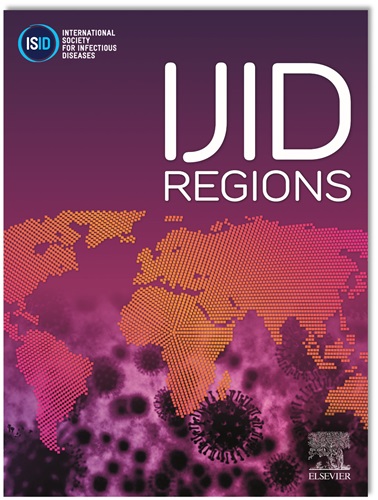Total burden of hepatitis B and C attributed to injecting drug use in 204 countries and territories from 1990 to 2021: Analyses based on the Global Burden of Disease Study 2021
IF 4.8
2区 医学
Q1 INFECTIOUS DISEASES
引用次数: 0
Abstract
Objectives
This study assesses the global, regional, and national burden of hepatitis B virus (HBV) and hepatitis C virus (HCV) related to injecting drug use (IDU) from 1990 to 2021.
Methods
Data from the Global Burden of Disease Study 2021 were analyzed to quantify deaths, age-standardized mortality rates (ASMR), disability-adjusted life years (DALYs), and age-standardized DALYs rates (ASDR) due to HBV and HCV from IDU across 204 countries. Trends were evaluated using estimated annual percentage change. Analyzing the association between ASDR and SDI using a loess regression model.
Results
From 1990 to 2021, the global burden of deaths and DALYs due to HBV and HCV attributed to IDU showed an increasing trend, especially among males, whose mortality rates were significantly higher than females. In 2021, global deaths due to HBV from IDU were 13,050.8, with an ASMR of 0.15 per 100,000 and an ASDR of 5.3, both showing an increasing trend with estimated annual percentage changes (EAPCs) of 1.09 and 0.96, respectively. HCV deaths reached 231,764.4, with an ASMR of 2.68 (EAPC: 0.38) and a relatively stable ASDR trend (EAPC: 0.01). Although raw death rates for HCV have increased, the ASMR and ASDR have remained stable or slightly declined, highlighting different trends across sexes and regions. India had the highest national deaths, while the highest ASDRs were in the Republic of Moldova (HBV) and Mongolia (HCV). South Asia recorded the highest regional deaths for both HBV and HCV. Positive correlations between ASDRs for HBV and HCV with SDI were observed.
Conclusion
The burden of HBV and HCV due to IDU has increased from 1990 to 2021, especially among males, with significant regional and national disparities. Targeted drug prohibition interventions and policies are needed.
1990 年至 2021 年 204 个国家和地区因注射吸毒造成的乙型肝炎和丙型肝炎总负担:基于《2021 年全球疾病负担研究》的分析。
目标:本研究评估了 1990 年至 2021 年全球、地区和国家与注射吸毒有关的乙型肝炎 (HBV) 和丙型肝炎 (HCV) 负担:本研究评估了 1990 年至 2021 年与注射吸毒(IDU)相关的乙型肝炎(HBV)和丙型肝炎(HCV)在全球、地区和国家范围内的负担:对 2021 年全球疾病负担研究的数据进行了分析,以量化 204 个国家因注射吸毒导致的乙型肝炎病毒和丙型肝炎病毒引起的死亡人数、年龄标准化死亡率 (ASMR)、残疾调整生命年 (DALY) 和年龄标准化残疾调整生命年率 (ASDR)。采用估计的年度百分比变化对趋势进行评估。使用loess回归模型分析ASDR与SDI之间的关联:从 1990 年到 2021 年,全球因注射吸毒导致的 HBV 和 HCV 死亡负担和残疾调整寿命年数呈上升趋势,尤其是男性的死亡率明显高于女性。2021年,全球因注射吸毒导致的乙肝病毒死亡人数为13,050.8人,年均死亡率为每10万人0.15人,年均病死率为5.3人,两者均呈上升趋势,估计年均百分比变化分别为1.09和0.96。HCV死亡人数达到231764.4人,ASMR为2.68(EAPC:0.38),ASDR趋势相对稳定(EAPC:0.01)。虽然 HCV 的原始死亡率有所上升,但 ASMR 和 ASDR 保持稳定或略有下降,凸显了不同性别和地区的不同趋势。印度的全国死亡率最高,而 ASDR 最高的国家是摩尔多瓦共和国(HBV)和蒙古(HCV)。南亚地区的 HBV 和 HCV 死亡率最高。HBV和HCV的ASDR与SDI之间呈正相关:结论:从 1990 年到 2021 年,因注射吸毒导致的 HBV 和 HCV 负担有所增加,尤其是在男性中,而且地区和国家之间存在显著差异。需要采取有针对性的禁药干预措施和政策。
本文章由计算机程序翻译,如有差异,请以英文原文为准。
求助全文
约1分钟内获得全文
求助全文
来源期刊
CiteScore
18.90
自引率
2.40%
发文量
1020
审稿时长
30 days
期刊介绍:
International Journal of Infectious Diseases (IJID)
Publisher: International Society for Infectious Diseases
Publication Frequency: Monthly
Type: Peer-reviewed, Open Access
Scope:
Publishes original clinical and laboratory-based research.
Reports clinical trials, reviews, and some case reports.
Focuses on epidemiology, clinical diagnosis, treatment, and control of infectious diseases.
Emphasizes diseases common in under-resourced countries.

 求助内容:
求助内容: 应助结果提醒方式:
应助结果提醒方式:


